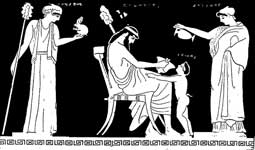.
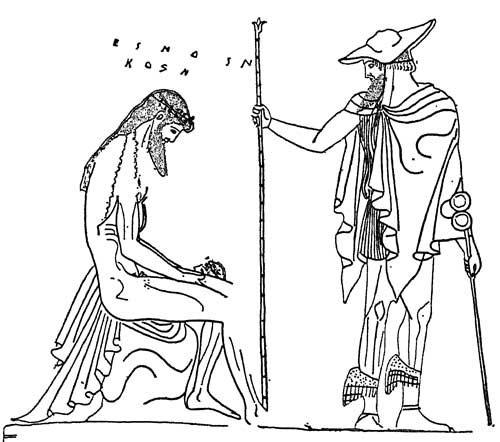
Birth of Dionysus from Zeus' thigh, Alkimachos painter, c. 470 BC
Elements: thyrsos, stick entwined with ivy and vine, crowned with a pine cone, grapes (staphyle)
Epithets: Dendrites, Omophagos, Phloios,...
Animals: Goat (Tragos) , panther/leopard (pardalis)
Dionysus (or Dionysos; Διόνυσος ,also known as Bacchus in Roman mythology and associated with the Italic Liber), the Thracian god of wine, represents not only the intoxicating power of wine, but also its social and beneficent influences. He is viewed as the promoter of civilization, a lawgiver, and lover of peace — as well as the patron deity of both agriculture and the theater.
Greeks borrowed Dionysus' figure and within the Olympian tradition he is made to be the son of Zeus and Semele; other versions of the story contend that he is the son of Zeus and Persephone.
Dionysus is a god of mystery religious rites, such as those practiced in honor of Demeter and Persephone at Eleusis near Athens. In the Thracian mysteries, he wears the "bassaris" or fox-skin, symbolizing new life. (See also Maenads)
Many scholars believe that Dionysus is a syncretism of a local Greek nature deity and a more powerful god from Thrace or Phrygia such as Sabazios.

Personifications: Nysa, Anatrofi, Nymphs, Tropheus, Ambrosia, Hermes and Dionysus, Nektar and Theogonia, Paphos Mosaics
Herodotus, (in Histories 2:146) was aware that the worship of Dionysus arrived later among the Greeks than the Olympian pantheon, for he remarks
"as it is, the Greek story has it that no sooner was Dionysus born than Zeus sewed him up in his thigh and carried him away to Nysa in Ethiopia beyond Egypt; and as for Pan, the Greeks do not know what became of him after his birth. It is therefore plain to me that the Greeks learned the names of these two gods later than the names of all the others, and trace the birth of both to the time when they gained the knowledge.
Many Greeks were sure that the cult of Dionysus arrived in Greece from Anatolia, but Greek concepts of where Nysa was, whether set in Anatolia, or in Libya ('away in the west beside a great ocean'), Ethiopia (Herodotus), or Arabia (Diodorus Siculus), are variable enough to suggest that a magical distant land was intended, perhaps named 'Nysa' to explain the god's unreadable name, as the 'god of Nysa.' Apollodorus seems to be following Pherecydes, who relates how the infant Dionysus, god of the grapevine, was nursed by the rain-nymphs, the Hyades at Nysa. The Anatolian Hittites' name for themselves in their own language ("Nesili") was "Nesi," however. The Hittites' influence on early Greek culture is often unappreciated.
The above contradictions suggest to some that we are dealing not with the historical memory of a cult that is foreign, but with a god in whom foreignness is inherent. And indeed, Dionysus's name is found on Mycenean Linear B tablets, and Kerenyi traces him to Minoan Crete, where his Minoan name is unknown but his characteristic presence is recognizable. Clearly, Dionysus had been with the Greeks and their predecessors a long time, and yet always retained the feel of something alien.
The bull, the serpent, the ivy and wine are the signs of the characteristic Dionysian atmosphere, infused with the unquenchable life of the god. Their numinous presence signifies that the god is near. (Kerenyi 1976). Dionysus is strongly associated with the satyrs, centaurs and sileni. He always carries a thyrsus (thyrsos). Besides the grapevine and its wild barren alter-ego, the toxic ivy plant, both sacred to him, the fig was also his. The pine cone that tipped his thyrsus linked him to Cybele, and the pomegranate linked him to Demeter.
The Dionysia and Lenaia festivals in Athens was also dedicated to Dionysus.
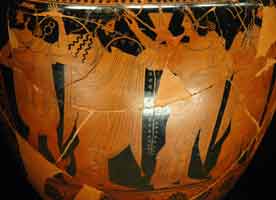
Bacchanalia
Introduced into Rome (c. 200 BC) from the Greek culture of lower Italy or by way of Greek-influenced Etruria, the bacchanalia were held in secret and attended by women only, on three days in the year in the grove of Simila near the Aventine Hill, on March 16 and 17. Subsequently, admission to the rites were extended to men and celebrations took place five times a month. The notoriety of these festivals, where many kinds of crimes and political conspiracies were supposed to be planned, led in 186 BC to a decree of the Senate — the so-called Senatus consultum de Bacchanalibus, inscribed on a bronze tablet discovered in Calabria (1640), now at Vienna — by which the Bacchanalia were prohibited throughout all Italy except in certain special cases which must be approved specifically by the Senate. In spite of the severe punishment inflicted on those found in violation of this decree, the Bacchanalia were not stamped out, at any rate in the south of Italy, for a very long time.
Dionysus is equated with both Bacchus and Liber (also Liber Pater). Liber ("the free one") was a god of fertility and growth, married to Libera. His festival was the Liberia, celebrated on March 17.
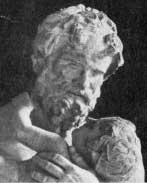
Silenus with the infant Dionysus, Louvre
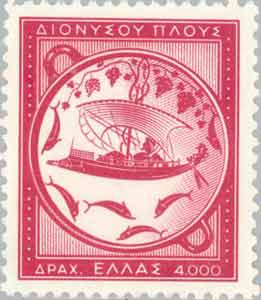
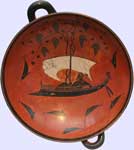
Dionysus and pirates (From an Attic Black Figure kylix) 530 BC by Exekias (Staatliche Antikensammlungen, Munich, Germany Inv. 2044). Dionysus with his divine power causes the growth of vines on the ship. As an exercise find where the pirates are!
Birth
Dionysus had an unusual birth that evokes the difficulty in fitting him into the Olympian pantheon. His mother was Semele (daughter of Cadmus), a mortal woman, and his father Zeus, the king of the gods. Zeus's wife, Hera, a jealous and vain goddess, discovered the affair while Semele was pregnant. Appearing as an old crone, Hera befriended Semele, who confided in her that her husband was actually Zeus. Hera pretended not to believe her, and planted seeds of doubt in Semele's mind. Curious, Semele demanded of Zeus that he reveal himself in all his glory as proof of his godhood. Though Zeus begged her not to ask this, she persisted and he agreed. Mortals, however, can not look upon a god without dying, and she perished. Zeus rescued the fetal Dionysus, however, by sewing him into his thigh. A few months later, Dionysus was born.
In another version of the same story, Dionysus was the son of Zeus and Persephone, the queen of the underworld. A jealous Hera again attempted to kill the child, this time by sending Titans to rip Dionysus to pieces after luring the baby with toys. Though Zeus drove the Titans away with his thunderbolts but only after the Titans ate everything but the heart, which was saved, variously, by Athena, Rhea, or Demeter. Zeus used the heart to recreate Dionysus and implant him in the womb of Semele, hence he was again "the twice-born". Sometimes it was said that he gave Semele the heart to eat to impregnate her. The rebirth in both versions of the story is the primary reason he was worshipped in mystery religions, as his death and rebirth were events of mystical reverence. This narrative was apparently used in certain Greek and Roman mystery religions. Variants of it are found in Callimachus and Nonnus, who refer to this Dionysus under the title Zagreus, and also in several fragmentary poems attributed to Orpheus.
Childhood
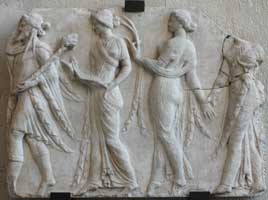
The legend goes that Zeus took the infant Dionysus and gave him in charge to the rain-nymphs of Nysa, who nourished his infancy and childhood, and for their care Zeus rewarded them by placing them, as the Hyades among the stars (see Hyades star cluster). Alternatively, he was raised by Maro.
When Dionysus grew up he discovered the culture of the vine and the mode of extracting its precious juice; but Hera struck him with madness, and drove him forth a wanderer through various parts of the earth. In Phrygia the goddess Rhea cured him and taught him her religious rites, and he set out on a progress through Asia teaching the people the cultivation of the vine. The most famous part of his wanderings is his expedition to India, which is said to have lasted several years. Returning in triumph he undertook to introduce his worship into Greece, but was opposed by some princes who dreaded its introduction on account of the disorders and madness it brought with it. (See King Pentheus or Lycurgus.)
As a young man, Dionysus was exceptionally attractive. Once, while disguised as a mortal on a ship, the sailors attempted to kidnap him for their sexual pleasures. Dionysus mercifully turned them into dolphins but saved the captain, Acoetes, who recognized the god and tried to stop his sailors.
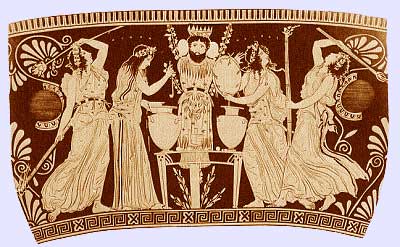
Wine offering to Dionysus
Midas
Once, Dionysus found his old school master and foster father, Silenus, missing. The old man had been drinking, and had wandered away drunk, and was found by some peasants, who carried him to their king, Midas (alternatively, he passed out in Midas' rose garden). Midas recognized him, and treated him hospitably, entertaining him for ten days and nights with politeness, while Silenus entertained Midas and his friends with stories and songs. On the eleventh day he brought Silenus back to Dionysus. Dionysus offered Midas his choice of whatever reward he wanted. Midas asked that whatever he might touch should be changed into gold. Dionysus consented, though was sorry that he had not made a better choice. Midas rejoiced in his new power, which he hastened to put to the test. He touched and turned to gold an oak twig and a stone. Overjoyed, as soon as he got home, he ordered the servants to set a feast on the table. Then he found that his bread, meat, daughter and wine turned to gold.
Upset, Midas strove to divest himself of his power (the Midas Touch); he hated the gift he had coveted. He prayed to Dionysus, begging to be delivered from starvation. Dionysus heard and consented; he told Midas to wash in the river Pactolus. He did so, and when he touched the waters the power passed into them, and the river sands became changed into gold. (Note: this explained why the sands of the river Pactolus were rich in gold)
Other Stories
When Hephaestus bound Hera to a magical chair, Dionysus got him drunk and brought him back to Olympus after he had passed out. For this act, he was made one of the twelve Olympians.
Acis, a Sicilian youth, was sometimes said to be Bacchus' son. A satyr named Ampelos was a good friend of Bacchus.
Callirhoe was a Calydonian woman who scorned a priest of Dionysus who threatened to inflict all the women of Calydon with insanity (see Maenad). The priest was ordered to sacrifice Callirhoe but he killed himself instead. Callirhoe threw herself into a well which was later named after her.
As Dionysus was almost certainly a late addition to the pantheon of Greek mythology, there was some hostility to his worship. Homer mentions him only briefly and with much hostility. Euripides also wrote a tale concerning the destructive nature of Dionysus in his play entitled The Bacchae. Since Euripedes wrote this play while in the court of King Archelaus of Macedon, some scholars believe that the cult of Dionysus was malicious in Macedon but benign in Athens. In the play, Dionysus returns to his birthplace, Thebes, ruled by his cousin, Pentheus. Pentheus was angry at the women of Thebes, including his mother, Agave, for denying his divinity and worshipping Dionysus against his will. The worshippers of Dionysus were known as blood-thirsty, wild women called Maenads. The women tore Pentheus to shreds after he was lured to the woods by Dionysus. His body was mutilated by Agave.
When King Lycurgus of Thrace heard that Dionysus was in his kingdom, he imprisoned all the followers of Dionysus, the Maenads. Dionysus fled, taking refuge with Thetis. Dionysus then sent a drought and the people revolted. Dionysus made King Lycurgus insane, and he sliced his own son into pieces with an axe, thinking he was a patch of ivy, a plant holy to Dionysus. An oracle then claimed that the land would stay dry and barren as long as Lycurgus was alive, so his people had him drawn and quartered. With Lycurgus dead, Dionysus lifted the curse.
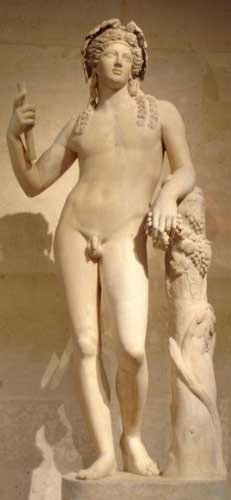
Statue of Dionysus, 2th century AD found in Italy, Louvre [Source]
Consorts/Children
Aphrodite (Hymenaios, Priapus, Charites: Aglaea , Euphrosyne , Thalia)
Ariadne (Oenopion )
Nyx (Phthonus)
Unknown mother (Acis )
Nicaia a Najad (Telete, Satyros)
Appellations
Dithyrambos ("he of the double door") is sometimes used to refer to him or solemn songs sung to him at festivals. The name refers to his premature birth. Eleutherios ("the liberator") was an epithet for both Dionysus and Eros. As Oeneus, he is the god of the wine-press. A winnowing fan was similar to a shovel and was used to separate the chaff from the good, cut grain. In addition, In the Greek pantheon, Dionysus (along with Zeus) absorbs the role of Sabazios, a Phrygian deity, whose name means "shatterer" and to whom shattered pottery was sacrificed (probably to prevent other pottery from being broken during firing). In the Roman pantheon, Sabazius became an alternate name for Bacchus.
Aesymnetes
Agrionios
Anthroporrhaistes, "man-destroyer" a title for Dionysus at Tenedos
Archegetes
Bakkheios
Bromios , meaning "the thunderer" or "he of the loud shout"
Dendrites; ("he of the trees"), as a powerful fertility god.
Eleutherios ; (Paus.1.38.8), and at Athens (Suid. s. v. Apatouria; Conon, Narrat. 39; Paus. 2.35.1)
Enchores
Erikepaios
Eriphios, 'goat kid,' name at Metapontum
Iacchus, possibly an epithet of Dionysus, is associated with the Eleusinian Mysteries; in Eleusis, he is known as a son of Zeus and Demeter. The name "Iacchus" may come from the iakchos, hymns sung in honor of Dionysus.
Kathegemon, name, example from an Pergamon Inscription
Liknites ("he of the winnowing fan") he is a fertility god connected with the mystery religions.
Lyaeus (Λυαῖος, “care-dispeller”) ("he who releases") as a god of relaxation and freedom from worry..
Meilikhios
Melanegis or Melanaigis, i.e. armed or clad with a black aegis, occurred as a surname of Dionysus at Eleutherae (Suidas)
Mainomenos, "the frenzied Dionysos", London E 439 Vase
Omadios, "Raw Meat-Eater", "of the Raw Feast"
Omestes, "Devourer", Themistocles sacrificed tree Persian prisoners at Salamis to Dionysus Omestes (Plut. Themist)
Patroios (Paternal)
Setaneios, Teos (Dionysos Temple)
Sphaleotas, "who causes staggering", Delphi (Beyond Apollo at Delphi :--the sanctuaries of Athena Pronaia, Demeter, and Dionysus Sphaleotas, Susan J. Wallrodt. (1995)
Thyllophoros
Thyonidas
Zagreus
In his book The Birth of Tragedy, the German philosopher Friedrich Nietzsche contrasted Dionysus with the god Apollo as a symbol of the basic, unrestrained life force versus the world of reason, form and beauty represented by the latter.
Inspired by James Frazer, some have labeled Dionysus a life-death-rebirth deity. The mythographer Karl Kerenyi devoted much energy to Dionysus over his long career; he summed up his thoughts in Dionysos: Dionysos: Archetypal Image of Indestructible Life, Carl Kerenyi
On Dionysus
Greek Wine History: Ancient Greece
| Olympians |
| Zeus and Hera |
| Poseidon, Hades, |
| Hestia, Demeter, |
| Aphrodite, Athena, |
| Apollo, Artemis, |
| Ares, Hephaestus, |
| Hermes, Dionysus |
Dionysus: myth and cult, Walter Friedrich Otto
Dionysos: archetypal image of indestructible life, Karl Kerényi
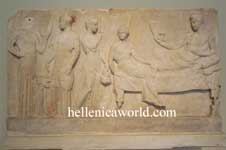
1500 : Dionysos, Votive relief. Marble Found in the Piraeus.

3494 : Dionysos. Table support. Pentelic marble.
Images
Birth of Dionysos from the thigh of Zeus, Alkimachos Painter, 460 B.C. red-figure Museum of Fine Arts, Boston
Statue of Dionysus "Sardanapalus"
Romantic Paintings
(Victorian Neoclassicism )
John William Godward (1861-1922),The Priestess of Bacchus.
Carl Kerenyi, Dionysos: Archetypal Image of Indestructible Life , Bollingen; Reprint edition (September 16, 1996) ISBN: 0691029156
Gods of the Greeks, Carl Kerenyi
Dionysos (Dionysus) / Bacchus Gallery
See also : Greek Mythology. Paintings, Drawings
| Ancient Greece
Science, Technology , Medicine , Warfare, , Biographies , Life , Cities/Places/Maps , Arts , Literature , Philosophy ,Olympics, Mythology , History , Images Medieval Greece / Byzantine Empire Science, Technology, Arts, , Warfare , Literature, Biographies, Icons, History Modern Greece Cities, Islands, Regions, Fauna/Flora ,Biographies , History , Warfare, Science/Technology, Literature, Music , Arts , Film/Actors , Sport , Fashion --- |
Retrieved from "http://en.wikipedia.org"
All text is available under the terms of the GNU Free Documentation License

